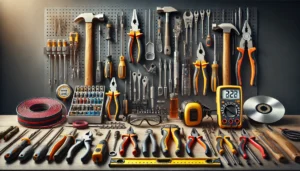As construction sites evolve, so do the tools needed to perform at the top of one’s ability. Cordless tools have redefined the standards on construction sites. They eliminate tangle issues while ensuring user safety, feeling light and effortless. This innovation means that tools can be used without the user being restricted to a certain area. Instead, they can finish their projects much quicker than before. This improvement in tool design will allow for improved efficiency by not allowing power cords to get in the way. With all these benefits, planning for how these tools will be integrated into the daily workflow can significantly reduce the amount of time it takes to perform tasks.
Enhanced Mobility and Flexibility
Old-fashioned corded tools have lots of safety risks, like the danger of getting shocked or tripping on the cord. However, the use of cordless tools reduces risks significantly because there are no cords to worry about, promoting a better working environment. Furthermore, many new cordless tools come with smart features like automatic shut-off, kickback prevention, and overload protection, making everything much safer on-site. These cuts in potential accidents allow reducing costs associated with injuries and makes the workplace safer in general.
Improved Safety
Traditional corded tools present several safety hazards, including tripping over cords and the risk of electrical shocks. By removing cords from the equation, cordless tools significantly reduce these risks, contributing to a safer working environment. Additionally, many modern cordless tools are designed with advanced safety features such as automatic shut-off and kickback prevention, further enhancing jobsite safety.
Time Savings
The time it takes to set up and take down everything when using corded tools can be quite significant when multiple tools are in use. With cordless tools, these work processes are very simple because they need almost no setup. Workers can invest more time into executing tasks and less time managing equipment, resulting in quicker completion. In addition, not having to look for outlets and extension cords can make daily operations much more efficient.
Advancements in Battery Technology
The improvements regarding battery technology have attempted to deal with the previous concerns on the use of cordless tools. The latest generation of lithium-ion batteries provide advantages such as long term use, quicker recharge times, and enhanced functioning, permitting the use of cordless implements for more sophisticated work. High-performance batteries can now deliver power to tools throughout the work-day, while super fast charging techniques result in less idle time during their non-use. Some systems feature additional batteries for quick changing to other harnessed tools. These methods greatly increase overall efficiency. This development means that cordless tools will be fully functional, even during the longest shifts.
Ergonomics and Worker Comfort
In most cases, cross tools are designed for comfort, for instance, good weight balance and easy grip. This decreases worker’s stress, especially when the work is of long duration, boosting productivity and decreasing chances of injuries. Ergonomic tools in physically challenging situations also boost the worker’s spirit and productivity so that less effort is needed to accomplish tasks more accurately.
Environmental Considerations
Tools that use batteries produce less noise during work as well as less air pollution which creates a more ideal working environment. This poses even greater significance in cities where there are strict noise pollution restrictions and emission regulations. There is also the added benefit of cost savings as there is no fuel consumption for the gas-powered tools, which consequently leads to a reduced carbon footprint. A significant amount of modern battery systems are also recyclable which aids the sustainability aims of an organization while lessening waste.
Integration with Digital Technologies
Numerous cordless tools have smart capabilities and can be coupled with digital features. This allows for the real-time tracking of a tool’s performance, how charged a device is, and the current status of maintenance. A majority of people involved in Project Management know how much downtime is expensive, so this type of technology allows for the mitigation of these costs due to enhanced management. Integrated technology further aids in decision-making as it is greatly helpful to project managers in adjusting the amount of tools used and making certain that the tools can always be used. A few devices have remote diagnostics, which allows the system to evaluate the operational state of the items remotely and aids in reducing the need to travel for managing tasks consequently boosting efficiency.
Cost Efficiency
Though the cost of cordless tools and compatible batteries may be a bit pricey at the start, they pay off in the long run. Firstly, they require little maintenance and the productivity of the workers is increased, which leads to cost savings. Another advantage is that battery systems are modular, which allows companies to add to their tool inventory without having to make large additional investments. Moreover, these tools come with fewer parts that need replacing, which lowers energy costs and solves modern construction issues economically.
Conclusion
The thoughtful use of cordless tools can greatly improve job site productivity. These tools increase mobility while also enhancing safety, and through the help of modern technology, enable workers to achieve their goals more efficiently. Being cost effective by reducing expenses on site, ergonomically friendly, and environmentally sustainable, cordless tools are becoming a necessity rather than a preference on construction sites. Companies that want to stay at the top of the game need to adopt cordless technology as the construction industry moves forward. Investing in the correct tools along with technological updates can help companies achieve milestones more quickly while maintaining the utmost safety and accuracy.










